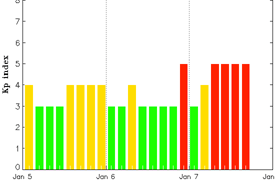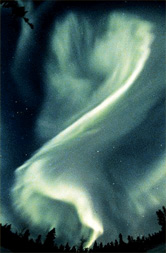



|
Auroras Auroras are light displays that can sometimes be seen in the night sky, especially at extreme northern and southern latitudes. Auroras are caused by energetic particles from the magnetosphere . Coronal mass ejections can bring about intense auroral displays. Ordinarily, the magnetosphere deflects most of the particles of the solar wind. However, some solar wind particles do manage to leak in. These enter the earth’s atmosphere along the magnetic field lines; that is, at the North and South Poles. When these particles (mainly electrons) collide with gas molecules (mainly oxygen and nitrogen) in the upper atmosphere, they excite the gas particles to higher energy states. As these gas molecules “de-excite” back down to lower energy levels, they release light. This light produces the often gorgeous auroras, which can be green, red, or purple, and appear as curtains, arcs, or clouds. Since charged particles enter our atmosphere at the poles, auroras are most often seen at extreme latitudes. A common latitude for sightings is 67°, or roughly the latitude of Fairbanks, Alaska. During geomagnetic storms, however, auroras may be visible at much lower latitudes. The likelihood of auroral displays can be predicted by tracking incoming particles. Particles entering the upper atmosphere are measured by a satellite orbiting the earth’s poles—the Polar-orbiting Operational Environmental Satellite, or POES. Data from this satellite are compared to statistical data of auroral sightings to produce the maps predicting where auroras are currently most likely. Geomagnetic Indicator |
|
|
© Exploratorium


